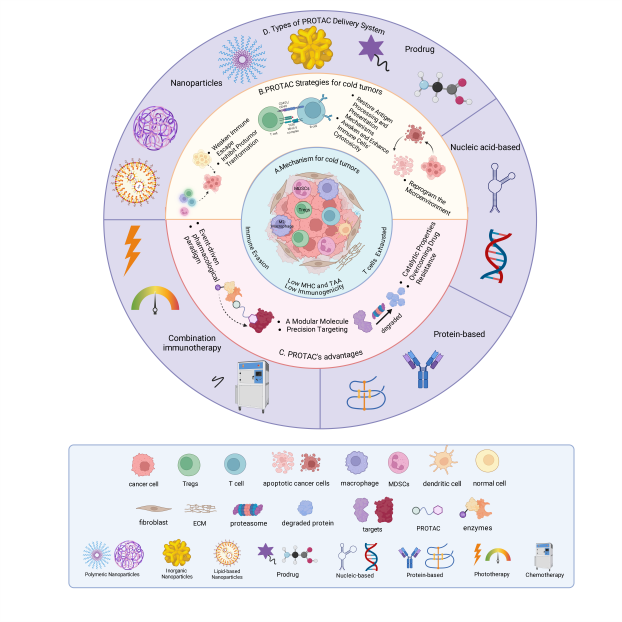
In the context of the immune microenvironment characteristics of cold tumors, PROTACs has demonstrated unique advantages, including solving drug resistance problems and non-patent drug targets. However, there is still a lack of complete guidance reviews on targeted PROTAC drug delivery systems that address the uniqueness and complexity of immunosuppressive microenvironments. Therefore, this research group reviewed the current status of immunotherapy for “cold tumor” and the latest progress in the design of drug delivery system based on PROTAC, in order to provide a new paradigm for cold tumor therapy. PROTAC Delivery in Tumor Immunotherapy: Where Are We and Where Are Going? Published online in the internationally renowned Journal of Controlled Release.
In recent years, with the introduction of the concept of “cold tumor”, it has become increasingly clear that traditional small molecule drugs have difficulties in achieving selective targeting of these tumors. Most of them are “occupancy-driven” as the mechanism of action, and there are often problems such as inefficiency and off-target toxicity in the treatment process. The emergence of PROTAC provides a new idea for cold tumor immunotherapy.

FIG. 1 Schematic diagram of cold tumor immunotherapy strategies, which summarizes the characteristics of cold tumor immunosuppressive microenvironment, potential applications of PROTAC therapy, advantages of PROTAC therapy, different delivery systems of PROTAC, and principles for designing these delivery systems.
In this paper, we first conducted a detailed review of cold tumor immunotherapy, summarized the causes of cold tumor formation, and emphasized the challenges of using immunotherapy to treat cold tumors and the urgent need to develop innovative therapeutic strategies to combat immune evasion. Subsequently, the research group turned to PROTACs (Proteolysis-Targeting Chimeras) to elucidate the “event-driven” mechanism of this molecule and its potential to degrade “undruggable targets”, revealing the application prospect of PROTAC in the development of therapeutic strategies for cold tumors. However, due to poor solubility, low permeability, low bioavailability of the system, non-specific biodistribution, and Hook effects, most PROTAC molecules are difficult to enter human clinical trials. The drug delivery system can effectively improve some of the limitations of PROTAC molecules, mainly including improving its physicochemical properties and increasing tissue specificity as a transport carrier.
Therefore, in the end, this paper focuses on a variety of PROTAC delivery systems, including nanoparticles, prodrug strategies, protein and nucleic acid based delivery systems, as well as the specific applications of these PROTAC delivery systems in the research and development of new drugs. These drug delivery systems can be loaded with PROTAC molecules, increase their effective concentration in the body, and extend their circulation time, improve stability and persistence, so that PROTAC can be targeted to specific lesion sites and enhance the targeting of treatment. It also discusses the principles to consider when designing these delivery systems and how these systems can be used to translate PROTAC technology from the laboratory to clinical applications. This review cited nearly 150 high-level literature, and made a detailed review of the research progress in this field in the past decade, which has practical reference value in this field.
Yiyang Li , Yike Wu and Sihan Gao are co-first authors of the paper, and Associate Professor Tao Sun and Professor Chen Jiang are corresponding authors. The research work has been supported by the National Key R&D Program of China, the National Natural Science Foundation of China, etc .
Original link:
https://www.sciencedirect.com/science/article/pii/S0168365924008356?via%3Dihub